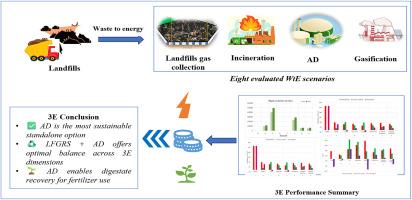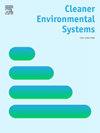金奈城市固体废物填埋场废物转化能源战略评估:使用能源-经济-环境(3E)方法的案例研究
IF 4.9
Q2 ENGINEERING, ENVIRONMENTAL
引用次数: 0
摘要
几十年来,城市固体废物的能源利用在全球范围内得到了广泛的应用。相比之下,钦奈市继续严重依赖垃圾填埋场处理生活垃圾,Kodungaiyur和Perungudi是该市的两个主要垃圾场。鉴于人们对温室气体(GHG)排放的日益关注和土地可用性的日益减少,迫切需要探索金奈固体废物管理的可持续替代方案。本研究评估了在金奈的Kodungaiyur和Perungudi垃圾填埋场实施废物转化为能源(WtE)技术的能源、经济和环境(3e)可行性。八种技术方案,包括垃圾填埋气体回收系统(LFGRS)、厌氧消化(AD)、焚烧、气化及其混合组合,是首选。厌氧消化(AD)被认为是金奈3e枢纽的帕累托最优解决方案,在能源回收、经济回报和环境绩效之间提供了最佳平衡。AD实现了最高的能量回收,产出和生产高达492,712 m3/天的沼气和1034.69 MWh/天的电力。经济上,在电力、区域供热和化肥收入的支持下,该公司的净利润为31,397美元至159,964美元/天。在环境方面,AD显示出强大的气候效益,与填埋相比,AD和传统填埋的净排放量减少到136.36吨二氧化碳/天,而填埋的平均排放量为2452吨二氧化碳/天。混合LFGRS和AD的净排放量大大降低,平均排放量为- 136.36吨二氧化碳/天。该场景也执行得很好,在所有维度之间提供了实际的平衡。这些结果强调了可扩展和平均259.24吨二氧化碳/天的LFGRS / AD的潜力,显示出强大的气候效益,这也使印度城市固体废物管理的消化物回收和可持续的WtE战略成为可能。本文章由计算机程序翻译,如有差异,请以英文原文为准。

Assessment of waste-to-energy strategies for municipal solid waste landfills in Chennai: A case study using energy-economic-environmental (3E) approach
The utilization of municipal solid waste (MSW) for energy production has been widely adopted across the globe for several decades. In contrast, Chennai city continues to rely heavily on landfilling for MSW disposal, with Kodungaiyur and Perungudi being the city's two major dumpsites. Given the growing concerns over greenhouse gas (GHG) emissions and diminishing availability of land, there is a pressing need to explore sustainable alternatives for solid waste management in Chennai.
This study evaluates the energy, economic, and environmental (3 E) feasibility of implementing Waste-to-Energy (WtE) technologies at the Kodungaiyur and Perungudi landfill sites in Chennai. Eight technology scenarios, including Landfill Gas Recovery Systems (LFGRS), Anaerobic Digestion (AD), incineration, gasification, and their hybrid combinations, are preferred. AD demonstrated Anaerobic Digestion (AD) was identified as the Pareto-optimal solution for Chennai's 3 E nexus, offering the best balance between energy recovery, economic returns, and environmental performance. AD achieved the highest energy recovery, generating output and producing up to 492,712 m3/day of biogas and 1034.69 MWh/day of electricity. Economically, it delivered net profits ranging from 31,397 to 159,964 USD/day, supported by revenues from electricity, district heating, and fertilizer. Environmentally, AD demonstrated strong climate benefits, with net emissions reduced to 136.36 tCO2/day, compared to the landfill, which emits an average of 2452 tCO2/day from AD and conventional landfilling. The hybrid LFGRS & AD achieve substantially lower net emissions, with AD averaging −136.36 tCO2/day. The scenario also performed well, offering a practical balance across all dimensions. These results underscore AD's potential as a scalable and LFGRS & AD averaging 259.24 tCO2/day, demonstrating strong climate benefits, which also enables digestate recovery and a sustainable WtE strategy for urban solid waste management in India.
求助全文
通过发布文献求助,成功后即可免费获取论文全文。
去求助
来源期刊

Cleaner Environmental Systems
Environmental Science-Environmental Science (miscellaneous)
CiteScore
7.80
自引率
0.00%
发文量
32
审稿时长
52 days
 求助内容:
求助内容: 应助结果提醒方式:
应助结果提醒方式:


